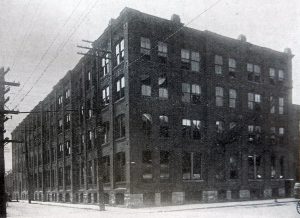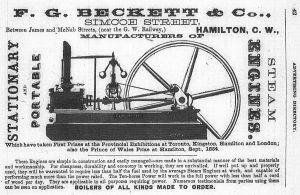Industrialization Comes to Hamilton
In the second half of the 19th-century, Hamilton was transformed from a commercial centre with a sprinkling of small artisan shops into Canada’s preeminent industrial city.
Most of Hamilton’s industrialists had started out in business as artisans, expanding their small shops as demand increased. Increasingly, they turned to steam engines to drive machinery through an elaborate system of belts, pulleys, wheels, and shafting in these enlarged plants.

Robert Nisbet’s small shop was transformed into John McPherson’s large manufactory in just a few decades.
Robert Nisbet’s downtown shop stood as an example of these changes. Nisbet opened a small boot and shoe shop in 1852, where he toiled long hours at the shoemaker’s bench. Just a decade later, his operation used the most modern shoemaking machinery available at the time. It was driven by a central steam engine. His workforce had swollen to 150 workers and in 1867 he sold the company to John McPherson. By 1897, John McPherson & Company was said to be the largest producer of high-quality footwear in Ontario.
By the 1860s, the city had bustling stove foundries, sewing machine factories, tobacco plants, a large clothing enterprise, a boot and shoe factory, and much more. These modern “manufactories” were still a far cry from the automated plants of the 20th-century, but they marked the beginning of changes to how work was performed and by whom.


